Two Reviews: CRISPR/Cas for genome engineering in plants, and Genome editing in cereal crops ($)
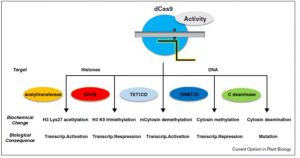 The gene-editing technology CRISPR/Cas, which introduces double-strand breaks that are repaired by non-homologous end joining (NHEJ), is best known for the promise it holds in modifying an organism’s DNA sequence without the introduction of exogenous genes. However, as Puchta describes (Curr. Opin. Plant Biol. 10.1016/j.pbi.2016.11.011), there are also many other ways that CRISPR/Cas can alter gene function and expression. In this review, he summarizes some of these other possibilities, which include: site-specific DNA integration of transgenes, single-base substitutions, targeting of transcriptional activators or repressors to regulatory sites, targeting histone-modifying enzymes, and in vivo genomic labeling. Other new approaches on the horizon include the use of an enzyme that produces double-strand breaks with a four-base overhang (leading to greater efficiency of repair than provided by Cas) and the application of CRISPR to RNA molecules. In a related review, Zhu et al. (Trends Plant Sci. 10.1016/j.tplants.2016.08.009) provide an overview of the application of CRISPR/Cas and other genome editing tools in crop plants, including a discussion of the frequency of off-target mutations. Tags: Applied Plant Biology, Molecular Biology, Synthetic Biology
The gene-editing technology CRISPR/Cas, which introduces double-strand breaks that are repaired by non-homologous end joining (NHEJ), is best known for the promise it holds in modifying an organism’s DNA sequence without the introduction of exogenous genes. However, as Puchta describes (Curr. Opin. Plant Biol. 10.1016/j.pbi.2016.11.011), there are also many other ways that CRISPR/Cas can alter gene function and expression. In this review, he summarizes some of these other possibilities, which include: site-specific DNA integration of transgenes, single-base substitutions, targeting of transcriptional activators or repressors to regulatory sites, targeting histone-modifying enzymes, and in vivo genomic labeling. Other new approaches on the horizon include the use of an enzyme that produces double-strand breaks with a four-base overhang (leading to greater efficiency of repair than provided by Cas) and the application of CRISPR to RNA molecules. In a related review, Zhu et al. (Trends Plant Sci. 10.1016/j.tplants.2016.08.009) provide an overview of the application of CRISPR/Cas and other genome editing tools in crop plants, including a discussion of the frequency of off-target mutations. Tags: Applied Plant Biology, Molecular Biology, Synthetic Biology
Review: Modeling stomatal conductance
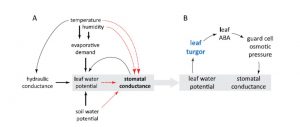 The transpiration rate of water though stomata, known as stomatal conductance or gs is one of the most critical and regulated of plant physiological processes. Buckley reviews recent progress on the development of comprehensive models of stomatal conductance, including the effect of soil moisture and air humidity, ABA synthesis and responses to light, CO2 and temperature. He also describes kinetic-based modelling of guard cell osmotic potential. Although challenges remain, Buckley concludes “Both process- and optimization-based models of stomatal conductance have become far more tractable, compact, and transparently related to measurable biophysical parameters and, therefore, more useful for forward modelling, which may soon obviate the current empirical modelling paradigm and help bridge research outcomes across scales of enquiry in plant physiology and ecology.” Plant Physiol. 10.1104/pp.16.01772 Tags: Computational Biology
The transpiration rate of water though stomata, known as stomatal conductance or gs is one of the most critical and regulated of plant physiological processes. Buckley reviews recent progress on the development of comprehensive models of stomatal conductance, including the effect of soil moisture and air humidity, ABA synthesis and responses to light, CO2 and temperature. He also describes kinetic-based modelling of guard cell osmotic potential. Although challenges remain, Buckley concludes “Both process- and optimization-based models of stomatal conductance have become far more tractable, compact, and transparently related to measurable biophysical parameters and, therefore, more useful for forward modelling, which may soon obviate the current empirical modelling paradigm and help bridge research outcomes across scales of enquiry in plant physiology and ecology.” Plant Physiol. 10.1104/pp.16.01772 Tags: Computational Biology
Review: Chloride on the move ($)
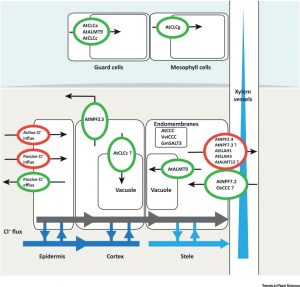 Saline soils are an ever growing problem, whether due to seawater incursions, for example in Bangladesh, or due to the rising water table in Australia. Salinity is harmful in three ways: non-specific osmotic effects, excess Na+, and excess Cl–. Of these, chloride has received the least attention. Li et al. review recent insights into the uptake and transport of Cl– into plants, including a review of chloride transporters that move Cl– into and out of the root, xylem vessels, cells and vacuoles. The involvement of ABA in Cl– homeostasis and strategies to increase plants’ tolerance to Cl– toxicity are discussed. Trends Plant Sci. 10.1016/j.tplants.2016.12.004 Tags: Bioenergetics, Transport
Saline soils are an ever growing problem, whether due to seawater incursions, for example in Bangladesh, or due to the rising water table in Australia. Salinity is harmful in three ways: non-specific osmotic effects, excess Na+, and excess Cl–. Of these, chloride has received the least attention. Li et al. review recent insights into the uptake and transport of Cl– into plants, including a review of chloride transporters that move Cl– into and out of the root, xylem vessels, cells and vacuoles. The involvement of ABA in Cl– homeostasis and strategies to increase plants’ tolerance to Cl– toxicity are discussed. Trends Plant Sci. 10.1016/j.tplants.2016.12.004 Tags: Bioenergetics, Transport
Review: New routes for plant iron mining
 Iron (Fe) is a frequently limiting nutrient for plant growth. Iron uptake requires that plants manipulate the extracellular environment through secretion of protons, chelators and other molecules. Curie and Mari review new studies on the importance of coumarin (phenolic compound) secretion in iron uptake, the role of the endodermis, and the role of cell walls and other apoplastic spaces as reservoirs of iron, as well as how the hormones ethylene and ABA contribute to iron homeostasis. New insights into how the developing embryo secures iron from maternal tissues are also described. New Phytol. 10.1111/nph.14364 Tags: Biochemistry, Metabolism, Transport
Iron (Fe) is a frequently limiting nutrient for plant growth. Iron uptake requires that plants manipulate the extracellular environment through secretion of protons, chelators and other molecules. Curie and Mari review new studies on the importance of coumarin (phenolic compound) secretion in iron uptake, the role of the endodermis, and the role of cell walls and other apoplastic spaces as reservoirs of iron, as well as how the hormones ethylene and ABA contribute to iron homeostasis. New insights into how the developing embryo secures iron from maternal tissues are also described. New Phytol. 10.1111/nph.14364 Tags: Biochemistry, Metabolism, Transport
Review: Industrial biomanufacturing: the future of chemical production ($)
 Our way of life depends on the chemical manufacture of thousands of products. Some of these can be produced through biomanufacturing, which may involve starting with a biological starting material, or using an enzyme or organism as catalyst. Advances in synthetic biology, metabolic engineering and genomics have all provided new opportunities for biomanufacturing. Clomburg et al. describe current applications of biomanufacturing, as well as its strengths and limitations. Two examples, the production of bioethanol and the manufacture of products from single-carbon feedstocks, are explored in depth. Science 10.1126/science.aag0804 Tags: Applied Plant Biology, Biochemistry, Bioenergy, Synthetic Biology
Our way of life depends on the chemical manufacture of thousands of products. Some of these can be produced through biomanufacturing, which may involve starting with a biological starting material, or using an enzyme or organism as catalyst. Advances in synthetic biology, metabolic engineering and genomics have all provided new opportunities for biomanufacturing. Clomburg et al. describe current applications of biomanufacturing, as well as its strengths and limitations. Two examples, the production of bioethanol and the manufacture of products from single-carbon feedstocks, are explored in depth. Science 10.1126/science.aag0804 Tags: Applied Plant Biology, Biochemistry, Bioenergy, Synthetic Biology
Opinion: ATG8 expansion as a driver of selective diversification of autophagy? ($)
 Autophagy is a process of selective membrane trafficking that delivers cargo to the vacuole or plasma membrane for recycling or secretion. ATG8 is a small ubiquitin-like protein that is required for formation of the double-membrane enclosed autophagy vesicle, the autophagosome. The ATG8 gene family has expanded greatly in plants, from one gene in algae to as many as 22 in some angiosperms. Kellner et al. examined the diversity of ATG8 proteins in plants and found that there are distinct ATG8 clades that are unique to particular plant families. The functional significance of this ATG8 diversification remains to be determined, but the authors suggest that different ATG8 isoforms may selectively interact with different protein targets and contribute to different autophagy-mediated processes. Trends Plant Sci. 10.1016/j.tplants.2016.11.015 Tags: Cell Biology, Computational Biology, Evolution, Molecular Biology
Autophagy is a process of selective membrane trafficking that delivers cargo to the vacuole or plasma membrane for recycling or secretion. ATG8 is a small ubiquitin-like protein that is required for formation of the double-membrane enclosed autophagy vesicle, the autophagosome. The ATG8 gene family has expanded greatly in plants, from one gene in algae to as many as 22 in some angiosperms. Kellner et al. examined the diversity of ATG8 proteins in plants and found that there are distinct ATG8 clades that are unique to particular plant families. The functional significance of this ATG8 diversification remains to be determined, but the authors suggest that different ATG8 isoforms may selectively interact with different protein targets and contribute to different autophagy-mediated processes. Trends Plant Sci. 10.1016/j.tplants.2016.11.015 Tags: Cell Biology, Computational Biology, Evolution, Molecular Biology
Water deficit-induced changes in transcription factor expression in maize seedlings ($)
 Understanding plant responses to water deficit is crucial for the development of drought-resilience, but complicated by the different ways plant researchers induce water deficit. Starting with the premise that transcription factors are important coordinators of water-deficit responses, Seeve et al. carried out a systematic analysis of maize transcription factor expression in response to defined water deficit conditions, using a vermiculite growth medium that provides reproducible water potential conditions. They identified nearly 400 water-deficit responsive transcription factors, providing a valuable resource for genetic mapping and breeding studies. Plant Cell Environ. 10.1111/pce.12891 Tags: Abiotic Interactions, Genomics, Gene Regulation
Understanding plant responses to water deficit is crucial for the development of drought-resilience, but complicated by the different ways plant researchers induce water deficit. Starting with the premise that transcription factors are important coordinators of water-deficit responses, Seeve et al. carried out a systematic analysis of maize transcription factor expression in response to defined water deficit conditions, using a vermiculite growth medium that provides reproducible water potential conditions. They identified nearly 400 water-deficit responsive transcription factors, providing a valuable resource for genetic mapping and breeding studies. Plant Cell Environ. 10.1111/pce.12891 Tags: Abiotic Interactions, Genomics, Gene Regulation
Root xylem plasticity to improve water use and yield in water-stressed soybean
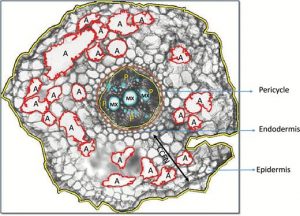 Root architecture and anatomy contribute to water uptake efficiency and plant performance under water-limitation. Prince et al. explored root anatomy in soybean, and identified metaxylem number as a key trait influencing performance under water-limiting conditions. Increases in metaxylem number were correlated with improved hydraulic conductivity, which enhances water transport. The authors observe that altering xylem size and number can enhance drought tolerance without incurring a penalty in irrigated conditions, and that selecting for xylem diameter has proven successful in a drought breeding program in wheat. These findings should prove useful for breeding soybeans for water-limited conditions. J. Exp. Bot. 10.1093/jxb/erw472 Tags: Abiotic interactions, Cell Biology, Ecophysiology, Physiology, Transport
Root architecture and anatomy contribute to water uptake efficiency and plant performance under water-limitation. Prince et al. explored root anatomy in soybean, and identified metaxylem number as a key trait influencing performance under water-limiting conditions. Increases in metaxylem number were correlated with improved hydraulic conductivity, which enhances water transport. The authors observe that altering xylem size and number can enhance drought tolerance without incurring a penalty in irrigated conditions, and that selecting for xylem diameter has proven successful in a drought breeding program in wheat. These findings should prove useful for breeding soybeans for water-limited conditions. J. Exp. Bot. 10.1093/jxb/erw472 Tags: Abiotic interactions, Cell Biology, Ecophysiology, Physiology, Transport
A shadow detector for photosynthesis efficiency ($)
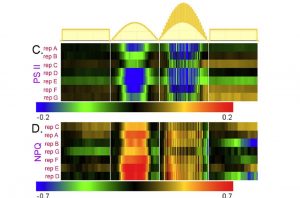 Efficient photosynthesis demands that plants have the capacity to capture photons when they are scarce, but at the same time not suffer damage from capturing more light energy than they are able to assimilate. To accomplish this, leaves need to be able to differentiate between a steady light level and light fluctuations, for example due to the fluttering movements of other leaves. AtRGS1, a receptor-like Regulator of G Signaling protein that is a component of a heterotrimeric G protein complex, is involved in glucose sensing. Liao et al. propose that AtRGS1 contributes to photosynthetic efficiency by serving as a “shadow sensor”. Their experimental results and results of their modeling suggest that glucose, a product of photosynthesis, acts through the G-protein complex (leading to an endocytosis cycle and a GTPase cycle) with a dose-duration reciprocity property, providing plants with the ability to filter out small fluctuations in light intensity or duration and so to adjust their photosynthetic capacity only under appropriate conditions. J. Theor. Biol. 10.1016/j.jtbi.2016.11.027 Tags: Bioenergetics, Computational Biology, Signals and Responses, Systems Biology
Efficient photosynthesis demands that plants have the capacity to capture photons when they are scarce, but at the same time not suffer damage from capturing more light energy than they are able to assimilate. To accomplish this, leaves need to be able to differentiate between a steady light level and light fluctuations, for example due to the fluttering movements of other leaves. AtRGS1, a receptor-like Regulator of G Signaling protein that is a component of a heterotrimeric G protein complex, is involved in glucose sensing. Liao et al. propose that AtRGS1 contributes to photosynthetic efficiency by serving as a “shadow sensor”. Their experimental results and results of their modeling suggest that glucose, a product of photosynthesis, acts through the G-protein complex (leading to an endocytosis cycle and a GTPase cycle) with a dose-duration reciprocity property, providing plants with the ability to filter out small fluctuations in light intensity or duration and so to adjust their photosynthetic capacity only under appropriate conditions. J. Theor. Biol. 10.1016/j.jtbi.2016.11.027 Tags: Bioenergetics, Computational Biology, Signals and Responses, Systems Biology
CATchUP: A web database providing information on spatiotemporal specific gene expression
 Nakamura et al. have created a searchable database, CATchUP (http://plantomics.mind.meiji.ac.jp/CATchUP) that allows the user to explore the spatiotemporal expression of genes across eight plant species (monocots and dicots) using data from publically available databases of large-scale RNA-Seq data. The authors define a parameter, Δdmax, which defines the “maximum difference in relative gene expression levels between sample runs which are neighboring when sorted by the levels” – in other words, genes that are strongly biased towards one tissue or condition. As examples, genes with a large Δdmax include the drought-inducible gene RD29B and the inflorescence-specific gene TFL1. Because several species are included in the database, it is possible to determine if a gene’s narrow expression profile is present in other species, facilitating the understanding of gene functions in plants. Plant Cell Physiol. 10.1093/pcp/pcw199 Tags: Computational Biology, Genomics, Gene Expression
Nakamura et al. have created a searchable database, CATchUP (http://plantomics.mind.meiji.ac.jp/CATchUP) that allows the user to explore the spatiotemporal expression of genes across eight plant species (monocots and dicots) using data from publically available databases of large-scale RNA-Seq data. The authors define a parameter, Δdmax, which defines the “maximum difference in relative gene expression levels between sample runs which are neighboring when sorted by the levels” – in other words, genes that are strongly biased towards one tissue or condition. As examples, genes with a large Δdmax include the drought-inducible gene RD29B and the inflorescence-specific gene TFL1. Because several species are included in the database, it is possible to determine if a gene’s narrow expression profile is present in other species, facilitating the understanding of gene functions in plants. Plant Cell Physiol. 10.1093/pcp/pcw199 Tags: Computational Biology, Genomics, Gene Expression
Mitochondrial dynamics during germination
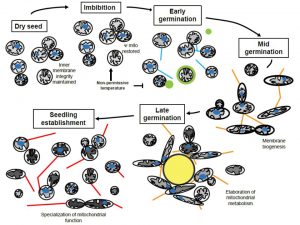 A seed undergoes a dramatic transformation from dried tissues into a mature plant. This change requires energy produced by oxidative metabolism, but dry seeds contain dormant promitochondria that need to be reactivated. Paszkiewicz et al. use bioimaging tools for an in vivo analysis of seed mitochondria biogenesis. Using a fluorescent dye to visualize the membrane potential, they show that seed mitochondria are capable of temperature-dependent oxygen uptake shortly after imbibition at 4°C and 21°C. The authors examine mitochondrial mobility in seeds, and they find mitochondria have limited mobility until perception of germination conditions, despite the presence of F-actin networks. Interestingly, when mitochondria become mobile, they fuse to form a transient tubular structure by the TR (testa rupture) stage. The tubular mitochondrial structure encircles the nucleus of each cell. The authors postulate this transient structure serves to redistribute mtDNA nucleoids among the mitochondria because the mtDNA remains stable during this stage. The redistribution of mtDNA could possibly lead to specialization among mitochondria to facilitate seedling growth. (Summary by Daniel Czerny) Plant Cell Tags: Bioenergetics, Cell Biology, Development
A seed undergoes a dramatic transformation from dried tissues into a mature plant. This change requires energy produced by oxidative metabolism, but dry seeds contain dormant promitochondria that need to be reactivated. Paszkiewicz et al. use bioimaging tools for an in vivo analysis of seed mitochondria biogenesis. Using a fluorescent dye to visualize the membrane potential, they show that seed mitochondria are capable of temperature-dependent oxygen uptake shortly after imbibition at 4°C and 21°C. The authors examine mitochondrial mobility in seeds, and they find mitochondria have limited mobility until perception of germination conditions, despite the presence of F-actin networks. Interestingly, when mitochondria become mobile, they fuse to form a transient tubular structure by the TR (testa rupture) stage. The tubular mitochondrial structure encircles the nucleus of each cell. The authors postulate this transient structure serves to redistribute mtDNA nucleoids among the mitochondria because the mtDNA remains stable during this stage. The redistribution of mtDNA could possibly lead to specialization among mitochondria to facilitate seedling growth. (Summary by Daniel Czerny) Plant Cell Tags: Bioenergetics, Cell Biology, Development
GET with it: Targeting of tail-anchored proteins via the GET system
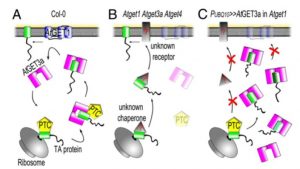 Students learn that membrane proteins are inserted into the endoplasmic-reticulum (ER) membrane co-translationally, but this mechanism does not hold for so-called tail-anchored (TA) proteins which carry a single C-terminal membrane spanning domain and insert into the ER membrane post-translationally. The mechanism of TA protein insertion was recently described in yeast as the GET (Guided Entry of Tail-anchored) system, which includes a protein complex that binds to and shields the transmembrane domain, a protein (GET3) that shuttles the protein to the ER, and ER-bound receptors that complete the insertion of the TA protein. Srivistava et al. (Plant Physiol 10.1104/pp.16.00928) recently demonstrated that in Arabidopsis the GET system is involved in the ER-membrane insertion of the TA protein SYP72. Xing et al. (Proc. Natl. Acad. Sci. USA 10.1073/pnas.1619525114) found that plants have two GET3 clades, a duplication that is also present in Lokiarchaeota (sister/precursor to eukaryotes), suggesting that rather than a plant-specific duplication, animals and fungi have lost one clade. Xing et al. also functionally characterize the genes encoding GET3 and other GET pathway components. Although get3 knock outs show only a modest root hair phenotype (suggesting an alternate route for TA protein insertion), plants are severely affected when GET3 is overexpressed in a get1 receptor mutant background, possibly due to accumulation of cytosolic aggregates of TA proteins. Tags: Biochemistry, Cell Biology, Evolution, Molecular Biology
Students learn that membrane proteins are inserted into the endoplasmic-reticulum (ER) membrane co-translationally, but this mechanism does not hold for so-called tail-anchored (TA) proteins which carry a single C-terminal membrane spanning domain and insert into the ER membrane post-translationally. The mechanism of TA protein insertion was recently described in yeast as the GET (Guided Entry of Tail-anchored) system, which includes a protein complex that binds to and shields the transmembrane domain, a protein (GET3) that shuttles the protein to the ER, and ER-bound receptors that complete the insertion of the TA protein. Srivistava et al. (Plant Physiol 10.1104/pp.16.00928) recently demonstrated that in Arabidopsis the GET system is involved in the ER-membrane insertion of the TA protein SYP72. Xing et al. (Proc. Natl. Acad. Sci. USA 10.1073/pnas.1619525114) found that plants have two GET3 clades, a duplication that is also present in Lokiarchaeota (sister/precursor to eukaryotes), suggesting that rather than a plant-specific duplication, animals and fungi have lost one clade. Xing et al. also functionally characterize the genes encoding GET3 and other GET pathway components. Although get3 knock outs show only a modest root hair phenotype (suggesting an alternate route for TA protein insertion), plants are severely affected when GET3 is overexpressed in a get1 receptor mutant background, possibly due to accumulation of cytosolic aggregates of TA proteins. Tags: Biochemistry, Cell Biology, Evolution, Molecular Biology
Effector-binding by integrated decoy domain of immune receptor RGA5 required for resistance activation
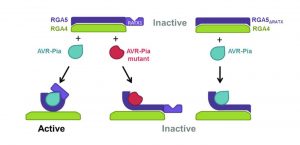 Magnaporthe oryzae is the fungus that causes rice blast disease, which is a serious threat to food security. Ortiz et al. explore the interaction between AVR-Pia, a fungal effector protein, and RGA5, a rice NLR (nucleotide-binding domain and leucine-rich repeat protein) immune receptor protein. RGA5 has a C-terminal domain, RATX1, that acts as an integrated target decoy and that has been shown as important for interaction with AVR-Pia. In this study, the authors use NMR and yeast two-hybrid assays to map the interaction between RGA5 and AVR-Pia. They show that activation of resistance requires AVR-Pia interaction with RGA5 in both central and RATX1 domains, and suggest that this interaction provides resilience to mutations in the effector. Plant Cell 10.1105/tpc.16.00435 Tags: Biochemistry, Biotic Interactions
Magnaporthe oryzae is the fungus that causes rice blast disease, which is a serious threat to food security. Ortiz et al. explore the interaction between AVR-Pia, a fungal effector protein, and RGA5, a rice NLR (nucleotide-binding domain and leucine-rich repeat protein) immune receptor protein. RGA5 has a C-terminal domain, RATX1, that acts as an integrated target decoy and that has been shown as important for interaction with AVR-Pia. In this study, the authors use NMR and yeast two-hybrid assays to map the interaction between RGA5 and AVR-Pia. They show that activation of resistance requires AVR-Pia interaction with RGA5 in both central and RATX1 domains, and suggest that this interaction provides resilience to mutations in the effector. Plant Cell 10.1105/tpc.16.00435 Tags: Biochemistry, Biotic Interactions
ROS accumulation and antiviral defence control by microRNA528 in rice
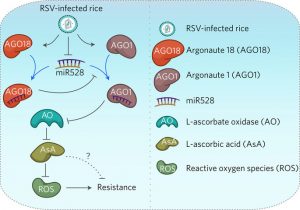 Several studies have implicated microRNAs in plant defenses against pathogens. Wu et al. previously showed that virus resistance is facilitated by the interaction of viral-inducible AGO18 (which is cleavage-inactive) and rice miR528. In this work, they identified the role of miR528 in viral resistance. Rice susceptibility to rice-stripe virus is positively correlated with miR528 expression level, indicating that miR528 negatively impacts defense. The authors showed that ascorbate oxidase (AO) is a direct target of miR528, and also that AO contributes to reactive oxygen (ROS) production. Therefore, when AGO18 binds miR528, ROS production and viral resistance are elevated. Nature Plants 10.1038/nplants.2016.203 Tags: Biochemistry, Biotic Interactions, Genetics, Molecular Biology
Several studies have implicated microRNAs in plant defenses against pathogens. Wu et al. previously showed that virus resistance is facilitated by the interaction of viral-inducible AGO18 (which is cleavage-inactive) and rice miR528. In this work, they identified the role of miR528 in viral resistance. Rice susceptibility to rice-stripe virus is positively correlated with miR528 expression level, indicating that miR528 negatively impacts defense. The authors showed that ascorbate oxidase (AO) is a direct target of miR528, and also that AO contributes to reactive oxygen (ROS) production. Therefore, when AGO18 binds miR528, ROS production and viral resistance are elevated. Nature Plants 10.1038/nplants.2016.203 Tags: Biochemistry, Biotic Interactions, Genetics, Molecular Biology

Dear Dr. Williams,
Its a really a good activity you started, basically what you are reading is always good and informative to me also. The newer and recent info in plant science, which I get easily, is a really good.
I am enjoying.
with best regards
Manoj
Thank you! It’s so helpful (and appreciated) to hear that this new initiative is helping the community!